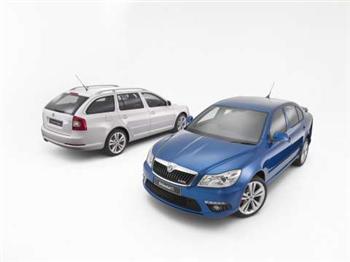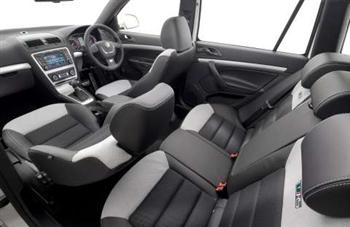|
Home | News | Road Tests | ||||||||||||
Skoda releases new Octavia RS
Although local sales have never achieved targets, Skoda Australia's new-look Octavia RS models is set for release in coming days. Its design, practicality and the level of standard equipment, set the Octavia RS apart from its rivals. Two high performance engines are available, a powerful 2.0 TFSI 147 kW four-cylinder petrol and the most powerful diesel engine in the Škoda range, a 2.0 TDI 125 kW four-cylinder engine. The new face of the Octavia RS shows itself in the expressive design of the front-end with new lighting elements. A choice of alloy wheels and paint colours allows even more individual specification of the Ocatvia RS. The front view is well defined by the new grille with the RS logo. The new headlamps, which can be equipped optionally with xenon lights and dynamic angle control with integrated headlight washers, are now significantly larger and more dominant. In the redesigned front bumper is a wider and more prominent air intake, while the optional cornering fog lamps not only find a place, but also, for the first time, LED daytime driving lights are fitted. The driving lights have a low power consumption of only 50 W. The redesigned model designation is now next to the rear lights. The Octavia RS comes in a choice of seven colours and comes standard with 18“ Neptune alloy wheels. Pricing for the new Skoda Octavia RS starts at $37,990* for the liftback and $39,990* for the wagon. The optional 6-speed DSG gearbox is $2,300. Since its European launch in 2000, 60,000 customers have chosen the Octavia RS, 70% of whom chose the wagon. The wagon is particularly popular in Germany, Switzerland and Italy, while the liftback is a great favourite in the UK and Spain. In Australia – where it has been available since October 2007 - the sales split has been balanced between the liftback and the wagon. The dynamically engaging Skoda Octavia RS is the performance flagship of the Octavia model line-up. Available, like the rest of the Octavia range, in both liftback and wagon body styles, this is a satisfying and very European performance car you can live with every day. Practicality is certainly not sacrificed by performance – nor vice-versa – when it comes to the Octavia RS. The driver will find an ergonomically perfect place in the interior. The workmanship and materials are particularly captivating. The Octavia RS provides lots of space for the occupants and their luggage, whether as a liftback or as a wagon. In the passenger compartment, there is a new RS interior trim – leather seats are an optional feature. The dual-zone climate control air conditioning is now equipped with AQS (Air Quality Sensor) which constantly measures the quality of the air drawn into the vehicle and, if necessary, automatically switches to recirculating the interior air. Apart from the comprehensive RS standard equipment, the list of options includes numerous possibilities to customise the Octavia RS. The options include the electric glass sunroof, front parking sensors and the Columbus Satellite Navigation system with 30GB hard drive as well as leather upholstery or privacy glass from the ‘B’ pillar backwards (wagon only). Spirited driving is assured with either the 2.0-litre TDI or TSI engines, which can be matched with either a six-speed manual or six-speed DSG transmission. Thanks to a powerful and refined 2.0 TSI in-line four-cylinder petrol engine with computer-controlled high-pressure direct injection, turbocharging and intercooling. Power peaks at an impressive 147 kW, which occurs across a 900 rpm range from 5,100 rpm to 6,000 rpm. Torque production is also strong and incredibly consistent across a broad operating range, with 280 Nm available from a low 1,800 rpm all the way to 5,000 rpm. The TSI engine variant has a fuel consumption of 7.7 litres/100 km (manual liftback and wagon, according to ADR81/02 standards) on the combined cycle and emits 179 g/km of CO2 (manual liftback and wagon, according to ADR81/02). The Octavia RS TSI manual liftback accelerates from 0 – 100 km/h in 7.3 seconds (manual wagon in 7.5 seconds). The Octavia RS TSI engine is now able to use 95 RON fuel as standard. The 2.0 TDI 125 kW common rail direct injection engine offered in the Octavia RS is the most powerful diesel engine in the Skoda range. Thanks to a relatively low compression ratio and very precise injector control, the 2.0 TDI is quiet and refined. The introduction of a separate catalyst and piezo injectors mean it also has tighter control over the actions of the standard fit diesel particulate filter (DPF). With 350 Nm of torque available between 1,750 and 2,500 rpm, this engine returns low fuel consumption of 5.9 litres/100 kms (manual liftback and wagon, according to ADR81/02) on the combined cycle and outputs 155 g/km of CO2 (manual liftback and wagon, according to ADR81/02). In terms of performance the 2.0 TDI is capable of taking the Skoda Octavia RS manual liftback from 0 to 100 km/h in 8.4 seconds (manual wagon in 8.5 seconds). Combining the benefits of both manual and automatic gearboxes, the optional six-speed DSG is best described as a ‘best of both worlds’ transmission. DSG has advantages over automated manual gearboxes too – it provides extremely quick gear changes resulting in virtually no loss of power when accelerating. It can be operated by the driver in the same way as an automatic Tiptronic transmission, yet fuel consumption is comparable to that of a traditional manual transmission. Unlike ordinary transmissions, DSG uses two input shafts, each with its own clutch. Gears 1, 3, 5 and reverse are on one shaft, while 2, 4 and 6 are on the other. The DSG transmission in the Skoda Octavia can be used by the driver in two modes – fully automatic or Tiptronic manual gear changing. The driver can also select between economy or sports mode. In sports mode the transmission changes gear at higher engine speeds, helping to maximise power output and therefore acceleration, whereas in economy mode the transmission changes at lower engine speeds, resulting in reduced fuel consumption. An essential element of any car involved in a crash is a carefully designed body shell with a rigid central passenger compartment and progressive crumple zones at the front and the rear. The Skoda Octavia RS is comprehensively kitted out to protect its occupants across a broad range of real-world safety situations with an impressive array of active (crash avoidance) and passive (crash mitigation) safety features. Six airbags, front whiplash optimised head restraints, the Electronic Stability Programme (ESP), advanced Anti-lock Brake System (ABS) and Anti-Slip Regulation (ASR) and Electronic Brake-pressure Distribution (EBD) are all standard in the Skoda Octavia RS range. ESP represents ‘best practice’ technology to counteract skids and slides, helping to prevent numerous subsequent traffic crashes. ESP has been independently assessed to offer significant safety benefits to the owners of cars fitted with the system, as well as other road users. It helps prevent loss of control situations from arising by monitoring cornering performance continuously and intervening automatically to regain control when it senses grip being lost.
It compares a complex number of variables in real time – such as yaw rate, lateral acceleration and steering angle, and is able to prevent sliding by reducing engine power if required and by braking individual wheels to control the car’s directional path when the available grip level is exceeded. Driver intervention is not required, as the system is entirely automatic. An advanced Anti-lock Brake System (ABS) helps maintain driver control by preventing wheel lock-up if an emergency stop is required, while a Anti-Slip Regulation (ASR) monitors the driveline continuously for wheel spin and automatically reduces engine output to prevent wheel slip. Finally, the Electronic Brake-pressure Distribution (EBD) provides an electronic means of regulating the ratio of front to rear brake pressure. The system automatically varies the settings according to driving and load conditions to ensure each wheel brakes to the optimum extent. Advanced structural engineering mitigates crash performance through controlled deformation, which limits loads on occupants while at the same time allowing a rigid survival space within the vehicle. Together with front, side and head airbags, and load-limiting seatbelt pre-tensioners, the Skoda Octavia RS is well equipped to protect its occupants from harm. Škoda Auto draws its inspiration for the Octavia RS from the long motor sport tradition of the company. Far ahead of their time, the company founders Václav Laurin and Václav Klement became involved in motor sport as early as 1901. In the early 1970s, the letter RS (Rally Sport) appeared for the first time on the Škoda 180 RS and Škoda 200 RS race cars. The near-production Škoda 130 RS, which was used successfully in rallies, circuit tracks and mountain races, tapped into their potential. Its greatest successes include the touring car victory at the Rally Monte-Carlo in 1977 and the European Touring Car Championship in 1981. NOTE:* Prices are manufacturer list prices only and exclude dealer fees and statutory charges. For the drive away price of Skoda vehicles interested parties should contact a Skoda dealer. | ||||||||||||
More Skoda News ..... here About | Car Clubs | Home | News | Road Ramblings | Road Tests | Subscribe | Top Drive © 2009 All rights reserved. Next Car Pty. Ltd. |





